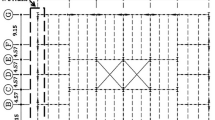Abstract
Different performance levels may be obtained for sideway collapse evaluation of steel moment frames depending on the evaluation procedure used to handle uncertainties. In this article, the process of representing modelling uncertainties, record to record (RTR) variations and cognitive uncertainties for moment resisting steel frames of various heights is discussed in detail. RTR uncertainty is used by incremental dynamic analysis (IDA), modelling uncertainties are considered through backbone curves and hysteresis loops of component, and cognitive uncertainty is presented in three levels of material quality. IDA is used to evaluate RTR uncertainty based on strong ground motion records selected by the k-means algorithm, which is favoured over Monte Carlo selection due to its time saving appeal. Analytical equations of the Response Surface Method are obtained through IDA results by the Cuckoo algorithm, which predicts the mean and standard deviation of the collapse fragility curve. The Takagi-Sugeno-Kang model is used to represent material quality based on the response surface coefficients. Finally, collapse fragility curves with the various sources of uncertainties mentioned are derived through a large number of material quality values and meta variables inferred by the Takagi-Sugeno-Kang fuzzy model based on response surface method coefficients. It is concluded that a better risk management strategy in countries where material quality control is weak, is to account for cognitive uncertainties in fragility curves and the mean annual frequency.
Similar content being viewed by others
References
Cornell CA, Jalayer F, Hamburger RO and Foutch DA (2002), “Probabilistic Basis for 2000 SAC Federal Emergency Management Agency steel moment frame guidelines,” Journal of Structural Engineering, 128(4): 526–533.
Dimova SL and Negro P (2006), “Assessment of Seismic Fragility of Structures with Consideration of the Quality of Construction,” Earthquake Spectra, 22(4): 909–936.
Ellingwood BR and Kinali K (2009), “Quantifying and Communicating Uncertainty in Seismic Risk Assessment,” Structural Safety, 31(2): 179–187.
Erberik MA (2008), “Generation of Fragility Curves for Turkish Masonry Buildings Considering In-plane Failure Modes,” Earthquake Engineering & Structural Dynamics, 37(3): 387–405.
Foutch DA and Yun SY (2002), “Modelling of Steel Moment Frames for Seismic Loads,” Journal of Constructional Steel Research, 58(5-8): 529–564.
Franchin P, Lupoi A and Pinto PE (2003), “Seismic Fragility of Reinforced Concrete Structures Using a Response Surface Approach,” Journal of Earthquake Engineering, 7(sup001): 45–77.
He JN and Wang Z (2011), “Analysis on System Reliability of Steel Framework Structure and Optimal Design,” Applied Mechanics and Materials, 105-107: 902–906.
Kappos AJ and Panagopoulos G (2010), “Fragility Curves for Reinforced Concrete Buildings in Greece,” Structure and Infrastructure Engineering, 6(1-2): 39–53.
Kircher CA, Reitherman RK, Whitman RV and Arnold C (1997), “Estimation of Earthquake Losses to Buildings,” Earthquake Spectra, 13(4): 703–720.
Kiureghian AD and Ditlevsen O (2009), “Aleatory or epistemic? Does It Matter?,” Structural Safety, 31(2): 105–112.
Kramer SL (1996), Geotechnical Earthquake Engineering, Prentice Hall, Upper Saddle River, N.J.
Li Q and Ellingwood BR (2008), “Damage Inspection and Vulnerability Analysis of Existing Buildings with Steel Moment-resisting Frames,” Engineering Structures, 30(2): 338–351.
Liel AB, Haselton CB, Deierlein GG and Baker JW (2009), “Incorporating Modelling Uncertainties in the Assessment of Seismic Collapse Risk of Buildings,” Structural Safety, 31(2): 197–211.
Lignos D (2008), Sidesway Collapse of Deteriorating Structural Systems under Seismic Excitations, ProQuest.
Lloyd SP (1982), “Least Squares Quantization in PCM,” IEEE Transactions on Information Theory, 28(2): 129–137.
Matlab (2014a), The Language of Technical Computing, Version 8.3, MathWorks.
Mitropoulou CC and Papadrakakis M (2011), “Developing Fragility Curves Based on Neural Network IDA Predictions,” Engineering Structures, 33(12): 3409–3421.
Möller B, Graf W and Beer M (2003), “Safety Assessment of Structures in View of Fuzzy Randomness,” Computers & Structures, 81(15): 1567–1582.
OpenSEES (2006), Open System for Earthquake Engineering Simulation, Pacific Earthquake Engineering Research Centre, University of California, Berkeley, (Release 2. 4. 2).
Pinto P, Giannini R and Franchin P (2007), “Seismic Reliability Analysis of Structures,” Earthquake Engineering & Structural Dynamics, 36(13): 2081-2081.
Rajabioun R (2011), “Cuckoo Optimization Algorithm,” Applied Soft Computing, 11(8): 5508–5518.
Rajeev P and Tesfamariam S (2012), “Seismic Fragilities for Reinforced Concrete Buildings with Consideration of Irregularities,” Structural Safety, 39: 1–13.
Rossetto T and Elnashai A (2005), “A New Analytical Procedure for the Derivation of Displacement-based Vulnerability Curves for Populations of RC Structures,” Engineering Structures, 27: 397–409.
Schotanus MIJ, Franchin P and Lupoi A (2004), “Seismic Fragility Analysis of 3D Structures,” Structural Safety, 26: 421–441.
Seo J and Linzell DG (2012), “Horizontally Curved Steel Bridge Seismic Vulnerability Assessment,” Engineering Structures, 34: 21–32.
Seo J and Linzell DG (2013), “Use of Response Surface Metamodels to Generate System Level Fragilities for Existing Curved Steel Bridges,” Engineering Structures, 52: 642–653.
Shinozuka M, Feng MQ, Lee J and Naganuma T (2000), “Statistical Analysis of Fragility Curves,” Journal of Engineering Mechanics, ASEC, 126(12): 1224–1231.
Shokri-Ghaleh H and Alfi A (2014), “Optimal Synchronization of Teleoperation Systems via Cuckoo Optimization Algorithm,” Nonlinear Dynamics, 78(4): 2359–2376.
Siler W and Buckley JJ (2005), Fuzzy Expert Systems and Fuzzy Reasoning, John Wiley & Sons.
Standard No. 2800 (2007), Iranian Code of Practice for Seismic Resistant Design of Buildings, Building and Housing Research Center, 3rd Edition, Iran.
Sugeno M (1985), “An Introduction Survey of Fuzzy Control,” Information Sciences, 36(1-2): 59–83.
Vamvatsikos D (2007), “Performing Incremental Dynamic Analysis in Parallel Using Computer Clusters,” In Proceedings of COMPDYN2007 Conference on Computational Methods in Structural Dynamics and Earthquake Engineering, Rethymno, Greece.
Zareian F, Krawinkler H, Ibarra L and Lignos D (2009), “Basic Concepts and Performance Measures in Prediction of Collapse of Buildings under Earthquake Ground Motions,” The Structural Design of Tall and Special Buildings, 19(1-2): 167–181.
Zolfaghari MR (2014), “Development of a Synthetically Generated Earthquake Catalogue towards Assessment of Probabilistic Seismic Hazard for Tehran,” Natural Hazards, 76(1): 497–514.
Author information
Authors and Affiliations
Corresponding author
Rights and permissions
About this article
Cite this article
Jough, F.K.G., Şensoy, S. Prediction of seismic collapse risk of steel moment frame mid-rise structures by meta-heuristic algorithms. Earthq. Eng. Eng. Vib. 15, 743–757 (2016). https://doi.org/10.1007/s11803-016-0362-9
Received:
Accepted:
Published:
Issue Date:
DOI: https://doi.org/10.1007/s11803-016-0362-9



